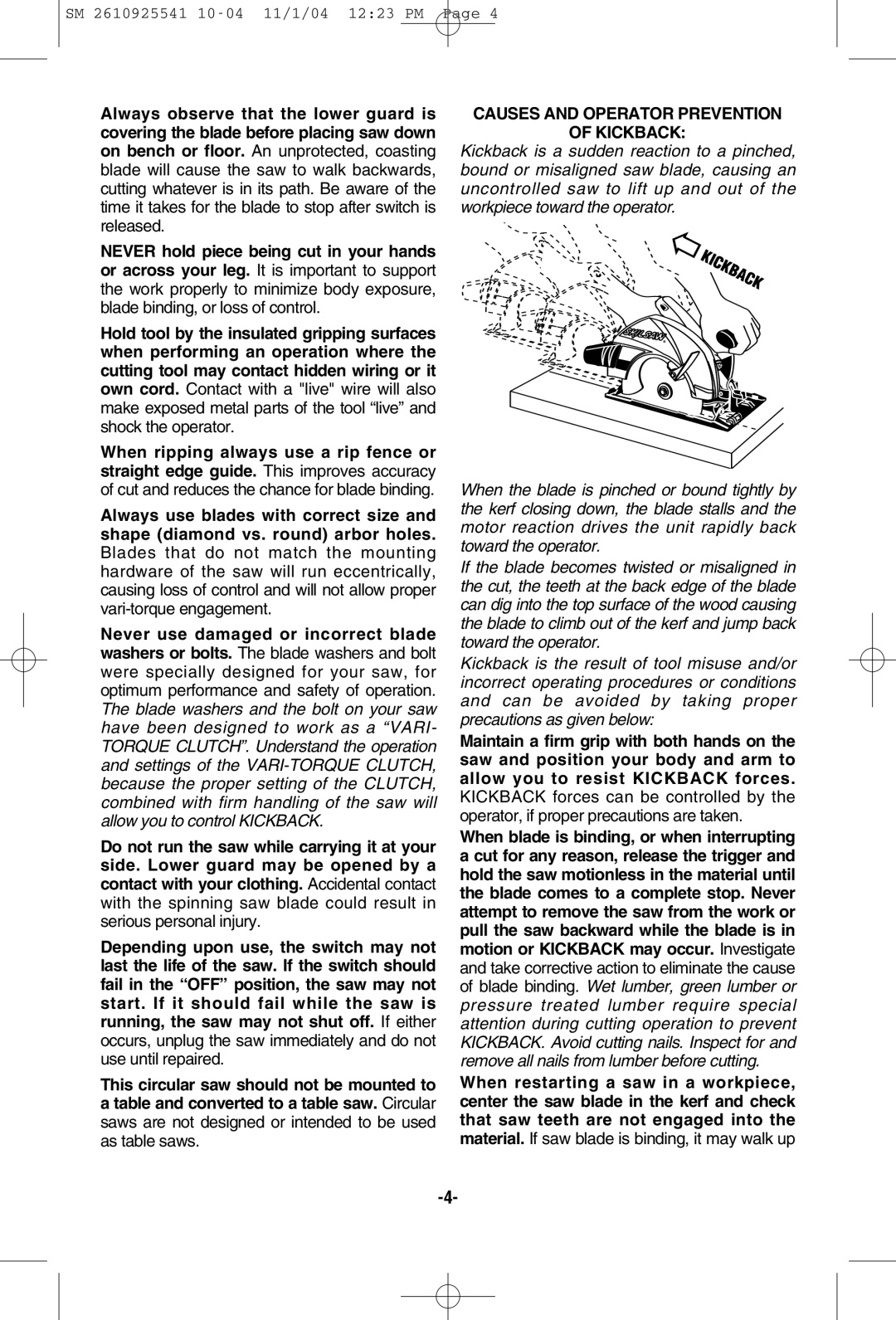
SM 2610925541
Always observe that the lower guard is covering the blade before placing saw down on bench or floor. An unprotected, coasting blade will cause the saw to walk backwards, cutting whatever is in its path. Be aware of the time it takes for the blade to stop after switch is released.
NEVER hold piece being cut in your hands or across your leg. It is important to support the work properly to minimize body exposure, blade binding, or loss of control.
Hold tool by the insulated gripping surfaces when performing an operation where the cutting tool may contact hidden wiring or it own cord. Contact with a "live" wire will also make exposed metal parts of the tool “live” and shock the operator.
When ripping always use a rip fence or straight edge guide. This improves accuracy of cut and reduces the chance for blade binding.
Always use blades with correct size and shape (diamond vs. round) arbor holes. Blades that do not match the mounting hardware of the saw will run eccentrically, causing loss of control and will not allow proper
Never use damaged or incorrect blade washers or bolts. The blade washers and bolt were specially designed for your saw, for optimum performance and safety of operation. The blade washers and the bolt on your saw have been designed to work as a “VARI- TORQUE CLUTCH”. Understand the operation and settings of the
Do not run the saw while carrying it at your side. Lower guard may be opened by a contact with your clothing. Accidental contact with the spinning saw blade could result in serious personal injury.
Depending upon use, the switch may not last the life of the saw. If the switch should fail in the “OFF” position, the saw may not start. If it should fail while the saw is running, the saw may not shut off. If either occurs, unplug the saw immediately and do not use until repaired.
This circular saw should not be mounted to a table and converted to a table saw. Circular saws are not designed or intended to be used as table saws.
CAUSES AND OPERATOR PREVENTION
OF KICKBACK:
Kickback is a sudden reaction to a pinched, bound or misaligned saw blade, causing an uncontrolled saw to lift up and out of the workpiece toward the operator.
When the blade is pinched or bound tightly by the kerf closing down, the blade stalls and the motor reaction drives the unit rapidly back toward the operator.
If the blade becomes twisted or misaligned in the cut, the teeth at the back edge of the blade can dig into the top surface of the wood causing the blade to climb out of the kerf and jump back toward the operator.
Kickback is the result of tool misuse and/or incorrect operating procedures or conditions and can be avoided by taking proper precautions as given below:
Maintain a firm grip with both hands on the saw and position your body and arm to allow you to resist KICKBACK forces.
KICKBACK forces can be controlled by the operator, if proper precautions are taken.
When blade is binding, or when interrupting a cut for any reason, release the trigger and hold the saw motionless in the material until the blade comes to a complete stop. Never attempt to remove the saw from the work or pull the saw backward while the blade is in motion or KICKBACK may occur. Investigate and take corrective action to eliminate the cause of blade binding. Wet lumber, green lumber or pressure treated lumber require special attention during cutting operation to prevent KICKBACK. Avoid cutting nails. Inspect for and remove all nails from lumber before cutting.
When restarting a saw in a workpiece, center the saw blade in the kerf and check that saw teeth are not engaged into the material. If saw blade is binding, it may walk up
